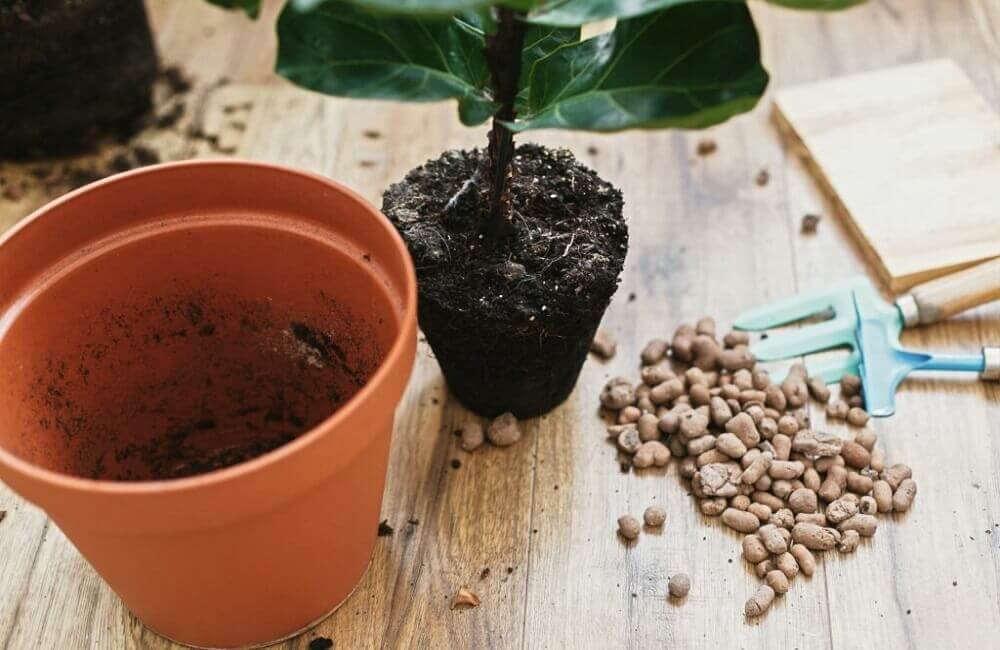
Fiddle leaf figs have earned worldwide popularity because of their big glossy green leaves and aesthetically appealing appearance. The houseplant increases the charm of your home instantly with its alluring beauty. However, the plant is quite sensitive to specific changes in the environment. But you cannot keep your houseplant in the same pot for too many days as it can lead to rootbound conditions.
Rootbound occurs when the roots of a plant displace all the soil mix and get a limited place that obstructs the growth. And fiddle leaf figs do not enjoy being in such a condition. If your house plant is rootbound, it can hardly absorb necessary nutrients and water and retain its health.
As a result, your houseplant starts to get dull, and weak, embracing death gradually. To avoid such an incident, always keep your keen eye on its roots. If the roots come out of the drainage holes, the chances are high that your beloved plant is about to get rootbound.
Sometimes, observing the roots alone cannot help prevent a fiddle leaf fig from getting root bound. So, you need to keep your senses active all the time and look for all the signs that the house plant shows. To make the assessment easier for the new plant owners, we will discuss the different symptoms of rootbound in your fiddle leaf fig plant and their best possible solutions.
TL; DR
If you notice the roots of your plant are spilling out of the drainage holes, your plant perhaps is developing a root bound. Apart from it, if the roots grow in a circular direction, the soil is dry, the leaves have brown spots, or the plant remains the same size with drooping leaves (stunted growth), there is a high possibility for your tree to get a rootbound. Once you notice any of these signs, immediately unpot your plant, loosen the roots, and repot it gently. Finally, place your plant in such a direction where it can get plenty of filtered sunlight, air, and moisture to settle down.
Table of Contents
Signs That Your Fiddle Leaf Fig Is Root Bound
Being a fiddle leaf fig owner, it is not new to you that the houseplant is susceptible to changes. That is why you should never repot your plant frequently. Repotting the plant once or twice a year is well and fine. Make sure not to skip the yearly repotting schedule because if you do so, your plant can end up getting a root bound.
But, how to tell that a fiddle leaf fig has got a rootbound? Well, the plant keeps giving hints about its condition. But most times, the owners fail to sense it. Today we are going to unfold all the signs that tell your plant is in a rootbound condition.
-
Ring-shaped Growth Of The Roots
The best way to tell whether your houseplant has rootbound is by observing its root growth. Generally, the roots of a fig plant grow in a vertical direction like other plants. However, if you notice that the roots are growing more in a hoop or ring-shaped around the pot, then your gorgeous houseplant definitely has rootbound.
-
Dry Soil
Dry and compact soil is another sign that indicates the rootbound condition in your green baby. If the soil mix in the pot becomes too dry and compact, your house plant can be bound in the container firmly.
-
Stunted Growth
Usually, fiddle leaf figs halt their growth when there is a change in their care routine. However, if you are following the same care regimen, but your beloved indoor plant has still stopped growing, you might need to replace the pot immediately.
-
Outgrowing Roots From The Drainage Holes
Now, this is something we have talked about repeatedly in our blogs. Outgrown roots that come out of the drainage holes are the most common sign of rootbound. And if you do not take any measures, your plant will be killed sooner or later.
The signs are not limited here. In a few cases, you can also notice cracking of the pots, droopy leaves with brown spots, plants leaning on a side, etc. When you notice one or more symptoms mentioned above, re-pot your plant with no more delay.
Top-notch Ways To Fix Your Plant’s Rootbound Condition
There is nothing much to worry about even if the roots of your plant are bound with the pot. It is because there are different ways by which you can restore the regular shape and growth of your green baby. Let’s find out what they are:
-
Plant Your Fiddle Fig Plant In A Comparatively Bigger Pot
Even when you plant your fiddle leaf fig in its sapling form, make sure it is in a bigger pot. Fiddle leaf figs grow pretty fast, and if the plant does not get more space for further growth, it can get root bound.
However, a too much bigger pot can lead to water retention, harming your beautiful fiddle leaf fig eventually. So, while choosing your container, make sure it’s neither big nor small. The size must be suitable for the plant. This way, you can let the fig roots move freely, cutting down the chances of root bound.
-
Choose A New Pot If It’s Already Rootbound
In case, your fiddle leaf fig plant is already in its rootbound state, then without wasting any more seconds, repot the plant. When choosing the new pot, make sure it is about 2 to 3inch larger than the former one. Also, the new container must have a smooth drainage system with lots of drainage holes. The pot must be super clean and spotless. You would definitely not want your plant to catch the pre-existing fungus and pathogens, right?
-
Take Out Your Plant Gently
Now, the most vital part of the repotting schedule is to handle the job gently! Never ever commit the mistake of pulling the plant forcefully. You might end up uprooting it.
Instead, slowly massage the roots to remove the soil, and when it is loosened up, gently ease out the plant from the old pot. If it’s hard to dislodge the soil from the roots, you may use some water. However, make sure that the water is not icy cool.
-
Repot Your Fiddle Leaf Fig
After you successfully remove the plant from the old pot, start your preparation to repot it. There are a few simple steps that you need to undertake before you place the plant in the new pot, and they include:
a. Prepare The Soil Mix
While preparing the soil mix, it is suggested that you keep the formula the same as previous. Otherwise, it can shock your plant, halting its natural growth. Fiddle leaf figs love soil that drains out water perfectly. To prepare such a soil mix, take two parts of soil and one part of peat moss and perlite, then blend everything well.
Read: What Is Best Soil For Fiddle Leaf Fig?
b. Eliminate The Damaged Parts Of The Roots
Watch out carefully if your fiddle leaf fig plant has any damaged roots. If you find any, cut them off gently using sterilized scissors. Otherwise, the damaged roots can affect the fresh ones and lead to root rot.
c. Plant The Fiddle Leaf Fig In The Pot
This is the final step of repotting your fiddle leaf fig. Gently take the pot, and add the soil mix covering ⅓ part. Then hold the stem of the plant straight and place it into the soil, and add some fresh soil on the sides so that the plant can stand straight without any support.
d. Aftercare
All these steps would definitely stress out your plant. To settle it down, following a proper aftercare routine is undeniably essential. Water the plant routinely and follow the usual care routine, and let your stunning houseplant feel homely and accustomed. However, fertilizing the plant in this state can worsen its condition, so hold it back for at least a month.
FAQs About Rootbound Fiddle Leaf Fig
How do I repot a big fiddle leaf fig plant?
First, take a big pot and fill it with 4 inches of your prepared soil mix, then hold the tree straight and fill the rest with fresh soil, water it, and let it settle down. Do not add manure to your plant immediately after repotting. Wait for at least a month before manuring it.
How can I fix root rot in my fiddle leaf fig plant?
Even though your fiddle leaf fig pot has a perfect drainage system, it can still experience root rot. At that moment, remove the plant from the pot, remove the damaged roots and repot it again. Add well-draining soil to the new well-draining pot. Make sure your plant is getting enough moisture and sunlight to restore its health.
Read: How To Fix Root Rot In Fiddle Leaf Fig?
Conclusion
Since you are the parent of your fiddle fig plant, it’s your responsibility to keep the plant healthy and beautiful. Weekly assessment of the plant structure, yearly repotting, and showering immense love and care on it can make your green baby thrive amazingly. Follow the above-listed steps to fix your plant’s root-bound condition and share with us whether it has worked for you.
Also, if you know any other tricks on preventing a rootbound condition in a fiddle leaf fig, write them in the comment section.
References:

From childhood, I have been extremely fascinated with plants and gardening. That has eventually led me to pursue BSc and then MSc in botany from the University of Calcutta. My deep love for plants has probably stemmed from the gorgeous terrace garden that I have seen my father nurture as long as I can remember.
